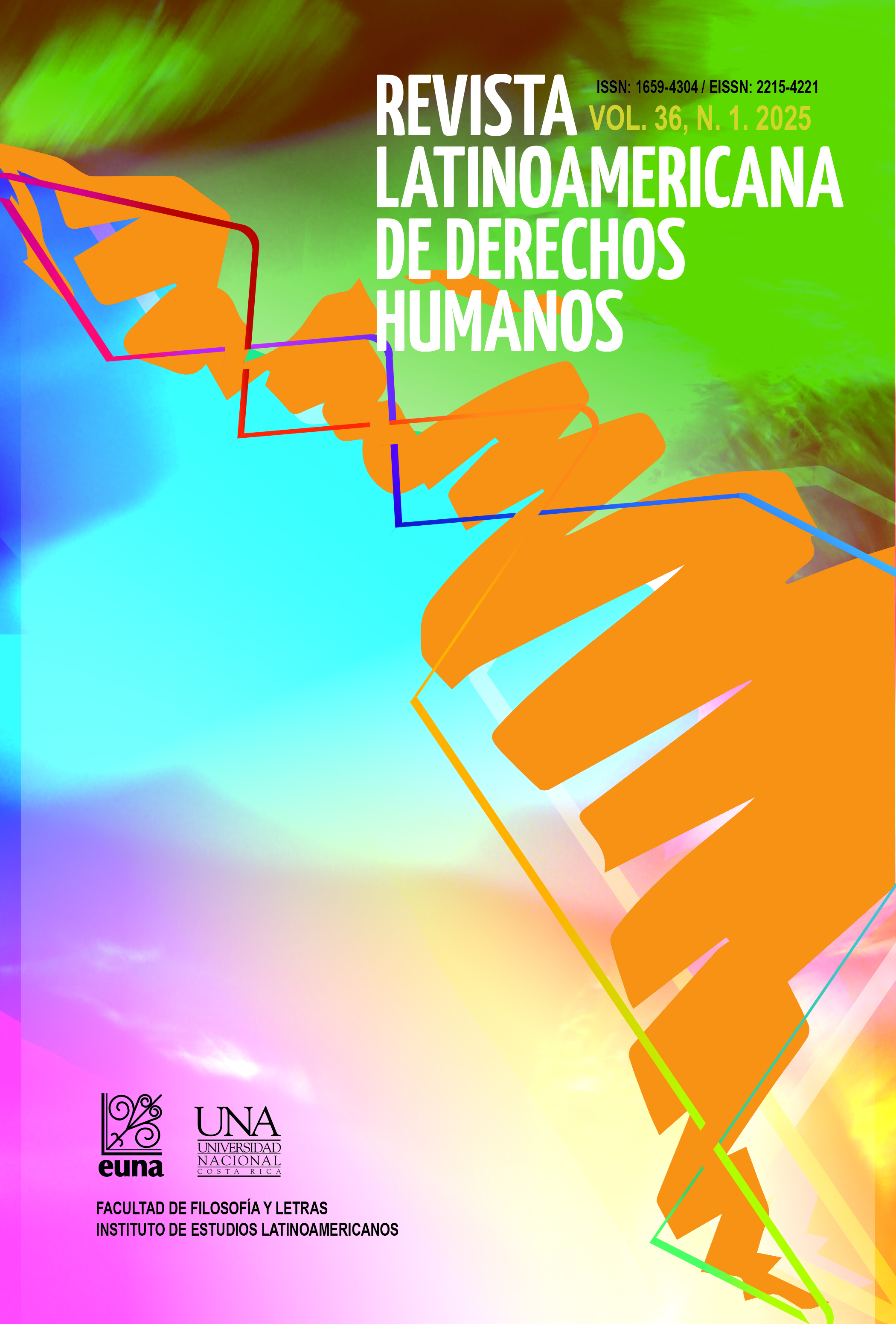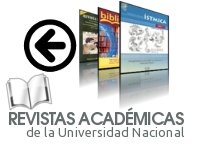Body as a Territory of Peace: A Proposal for Human Rights Education in Informal Spaces and Youth Contexts
DOI:
https://doi.org/10.15359/rldh.36-1.8Keywords:
body and territory, human rights education, informal education, peaceAbstract
This paper, Body as a Territory of Peace: A Proposal for Human Rights Education in Informal Spaces and Youth Contexts, aims to describe a pedagogical proposal to connect with the possibilities offered by informal learning and leisure spaces. These possibilities, combined with the simplicity of neighborhood contexts, enable approaching the (re)conceptualization of the body as a territory of peace from education for human rights and the claim of education for peace. It is proposed to use the controversial pedagogy and the pedagogy of liberation to establish a dialogic process taking into account the contribution provided in volume V, “Enduring war and rebuilding life: Impacts, confrontations and resistances,” from the report of the Comisión de la Verdad de Colombia (2022) [Colombian Truth Commission], to ultimately narrate the experience through the diversity offered by art. This pedagogical proposal offers an opportunity to heal the wounds and tend to the scars left by the internal armed conflict in Colombia, even when they seem invisible, claiming spaces of memory that history has also imprinted on the skin during our country's ongoing transition to peace.
References
Alcaldía Local de Kennedy. (s. f.). Historia de la Localidad de Kennedy. http://www.kennedy.gov.co/mi-localidad/conociendo-mi-localidad/historia
Alcaldía Local de Kennedy. (2024). Datos sobre la Localidad de Kennedy. Localidad de Kennedy | Bogota.gov.co.
Aponte, D., Pinzón, D. y Vargas, A. (2009). Barras de fútbol, juventud y conflictos: mapeo en la localidad de Kennedy (Bogotá). Centro de Recursos para el Análisis de Conflictos (CERAC). https://www.cerac.org.co/assets/pdf/Other%20publications/BarrasDeFutbol_Kennedy.pdf
Comisión de la Verdad. (2022). Sufrir la Guerra y Rehacer la Vida. Informe Final. https://www.comisiondelaverdad.co/sufrir-la-guerra-y-rehacer-la-vida
Cubillos Vega, C. (2019). La inclusión de los derechos humanos en la agenda del trabajo social: una aproximación a la educación en derechos humanos (EDH) en la formación académica. Universidad Complutense de Madrid. https://hdl.handle.net/20.500.14352/17152
Defensoría del Pueblo (Ed.). (2014). Estrategias y herramientas pedagógicas para la educación en derechos humanos. Editorial Nacional.
Domínguez, J. (1989). El concepto de obra de arte en la legislación mexicana. Revista Alegatos, 11, 12-18. Núm. 11: Enero-Abril 1989 | Alegatos (uam.mx) https://alegatos.azc.uam.mx/index.php/ra/article/view/897/874
Gómez, J. H. (2015). Las ciencias sociales escolares: entre la realidad y el deseo. Voces y Silencios. Revista Latinoamericana de Educación, 6(2), 101-113. https://doi.org/10.18175/vys6.2.2015.06
Jaramillo, J. (2012). Una sociología sentipensante para América Latina (antología). Latinoamérica. Revista de estudios Latinoamericanos (54), 315-324. http://www.scielo.org.mx/scielo.php?script=sci_arttext&pid=S1665-85742012000100015&lng=es&tlng=es.
Ley 115 de 1994. “Por la cual se expide la Ley General de Educación”. Febrero 8 de 1994. Publicado en el Diario Oficial No. 41.214 del 08 de febrero de 1994. https://www.funcionpublica.gov.co/eva/gestornormativo/norma.php?i=292
López, I. (2008). Educar en derechos humanos: un camino a la paz. Magisterio. Bogotá DC.
Magendzo, A. & Pavez, J. M. (2015). Educación en derechos humanos: una propuesta para educar desde la perspectiva controversial (1ª ed.). ISBN: 978-607-7625-95-7. Ciudad de México: Francisco Javier Conde González. 2015_libro_educaciondh.pdf (cdhcm.org.mx)
Magendzo, A. (2015). Educación en Derechos Humanos y Educación Superior: una perspectiva controversial. REencuentro. Análisis de Problemas Universitarios, (70), 47-69. https://www.redalyc.org/pdf/340/34046812004.pdf
Restrepo, Á. (2000). Mi cuerpo encuentra su voz y el artista su camino. Nómadas (Col), núm. 13, octubre, 2000, pp. 165-177. Universidad Central Bogotá, Colombia.
Restrepo, Á. (2003). Cuerpo y memoria (Escrito en el cuerpo). En Métodos, contenidos y enseñanza de las artes en América Latina y el Caribe (pp. 43-47). United Nations Educational Scientific and Cultural Organization (UNESCO). https://www.yumpu.com/s/lJm7FaJ43FcoJtYt
Restrepo, Á. (2005). Fragmentos de un discurso sobre el cuidado del cuerpo. En Toro J. & Rojas C. (Ed.). La educación desde las éticas del cuidado y la compasión (primera edición). Pontificia Universidad Javeriana. https://catalogobiblioteca.ufps.edu.co/cgi-bin/koha/opac-detail.pl?biblionumber=16221
Secretaría de Integración Social. (31/08/2022). Diagnóstico Loca Kennedy. Alcaldía de Bogotá. https://www.integracionsocial.gov.co/images/_docs/entidad/8_Diagnostico_local_Kennedy_2021_VF.pdf
Serrano, J. & Pons, R. (2011). El Constructivismo hoy: enfoques constructivistas en educación. Revista Electrónica de Investigación Educativa, 13(1), 1-27. http://www.scielo.org.mx/scielo.php?script=sci_arttext&pid=S1607-40412011000100001&lng=es&tlng=es
UNESCO. (2013). Human rights education in primary and secondary school systems: A self-assessment guide for governments. (Traducido al español). https://unesdoc.unesco.org/ark:/48223/pf0000222123
Published
How to Cite
Issue
Section
License
El material que se publica en esta Revista está bajo una licencia “Creative Commons” 3.0 Costa Rica (CC, Reconocimiento-NoComercial-SinObraDerivada 3.0 Costa Rica (CC BY-NC-ND 3.0 CR) . Esto significa que el material publicado en la revista se puede compartir (copiar y distribuir) en cualquier medio o formato considerando que se debe reconocer de forma adecuada la autoría del material y la fuente, no puede utilizarse con fines comerciales y no se aceptan las obras derivadas (remezclar, transformar o crear a partir del material).








